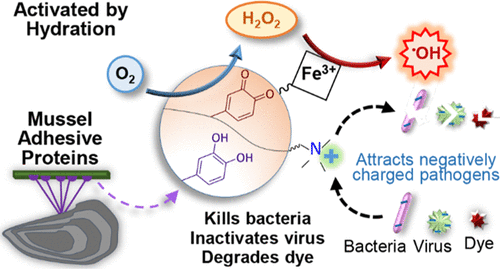当前位置:
X-MOL 学术
›
Chem. Mater.
›
论文详情
Our official English website, www.x-mol.net, welcomes your
feedback! (Note: you will need to create a separate account there.)
Hydroxyl Radical Generation through the Fenton-like Reaction of Hematin- and Catechol-Functionalized Microgels
Chemistry of Materials ( IF 7.2 ) Pub Date : 2020-09-04 , DOI: 10.1021/acs.chemmater.0c01551 Pegah Kord Forooshani 1 , Rattapol Pinnaratip 1 , Elizabeth Polega 1 , Ariana G Tyo 1 , Eric Pearson 2 , Bo Liu 1 , Tinu-Ololade Folayan 2 , Lei Pan 2 , Rupak M Rajachar 1 , Caryn L Heldt 2 , Bruce P Lee 1
Chemistry of Materials ( IF 7.2 ) Pub Date : 2020-09-04 , DOI: 10.1021/acs.chemmater.0c01551 Pegah Kord Forooshani 1 , Rattapol Pinnaratip 1 , Elizabeth Polega 1 , Ariana G Tyo 1 , Eric Pearson 2 , Bo Liu 1 , Tinu-Ololade Folayan 2 , Lei Pan 2 , Rupak M Rajachar 1 , Caryn L Heldt 2 , Bruce P Lee 1
Affiliation

|
Hydroxyl radical (•OH) is a potent reactive oxygen species with the ability to degrade hazardous organic compounds, kill bacteria, and inactivate viruses. However, an off-the-shelf, portable, and easily activated biomaterial for generating •OH does not exist. Here, microgels were functionalized with catechol, an adhesive moiety found in mussel adhesive proteins, and hematin (HEM), a hydroxylated Fe3+ ion-containing porphyrin derivative. When the microgel was hydrated in an aqueous solution with physiological pH, molecular oxygen in the solution oxidized catechol to generate H2O2, which was further converted to •OH by HEM. The generated •OH was able to degrade organic dyes, including orange II and malachite green. Additionally, the generated •OH was antimicrobial against both Gram-negative (Escherichia coli) and Gram-positive (Staphylococcus epidermidis) bacteria with the initial concentration of 106 to 107 cfu/mL. These microgels also reduced the infectivity of a nonenveloped porcine parvovirus and an enveloped bovine viral diarrhea virus by 3.5 and 4.5 log reduction values, respectively (99.97–99.997% reduction in infectivity). These microgels were also functionalized with positively charged [2-(methacryloyloxy)ethyl] trimethylammonium chloride, which significantly enhanced the antibacterial and antiviral activities through electrostatic interaction between the negatively charged pathogens and the microgel. These microgels can potentially serve as a lightweight and portable source of disinfectant for an on-demand generation of •OH with a wide range of applications.
中文翻译:

通过血红素和儿茶酚功能化微凝胶的类芬顿反应产生羟基自由基
羟基自由基 ( • OH) 是一种强效活性氧,能够降解有害有机化合物、杀死细菌和灭活病毒。然而,不存在用于生成• OH的现成、便携且易于激活的生物材料。在这里,微凝胶用儿茶酚(一种在贻贝粘附蛋白中发现的粘附部分)和血红素(HEM)(一种羟基化的含 Fe 3+离子的卟啉衍生物)进行功能化。当微凝胶在生理pH值的水溶液中水合时,溶液中的分子氧氧化儿茶酚生成H 2 O 2,H 2 O 2 进一步被HEM转化为• OH。生成的•OH 能够降解有机染料,包括橙色 II 和孔雀绿。此外,生成的• OH 对革兰氏阴性(大肠杆菌)和革兰氏阳性(表皮葡萄球菌)细菌均有抗菌作用,初始浓度为 10 6至 10 7cfu/毫升。这些微凝胶还将无包膜的猪细小病毒和有包膜的牛病毒性腹泻病毒的传染性分别降低了 3.5 和 4.5 log 降低值(传染性降低了 99.97-99.997%)。这些微凝胶还用带正电荷的[2-(甲基丙烯酰氧基)乙基]三甲基氯化铵进行了功能化,通过带负电荷的病原体和微凝胶之间的静电相互作用,显着增强了抗菌和抗病毒活性。这些微凝胶可潜在地用作轻量级和便携的消毒剂来源,用于按需生成• OH,具有广泛的应用。
更新日期:2020-10-13
中文翻译:

通过血红素和儿茶酚功能化微凝胶的类芬顿反应产生羟基自由基
羟基自由基 ( • OH) 是一种强效活性氧,能够降解有害有机化合物、杀死细菌和灭活病毒。然而,不存在用于生成• OH的现成、便携且易于激活的生物材料。在这里,微凝胶用儿茶酚(一种在贻贝粘附蛋白中发现的粘附部分)和血红素(HEM)(一种羟基化的含 Fe 3+离子的卟啉衍生物)进行功能化。当微凝胶在生理pH值的水溶液中水合时,溶液中的分子氧氧化儿茶酚生成H 2 O 2,H 2 O 2 进一步被HEM转化为• OH。生成的•OH 能够降解有机染料,包括橙色 II 和孔雀绿。此外,生成的• OH 对革兰氏阴性(大肠杆菌)和革兰氏阳性(表皮葡萄球菌)细菌均有抗菌作用,初始浓度为 10 6至 10 7cfu/毫升。这些微凝胶还将无包膜的猪细小病毒和有包膜的牛病毒性腹泻病毒的传染性分别降低了 3.5 和 4.5 log 降低值(传染性降低了 99.97-99.997%)。这些微凝胶还用带正电荷的[2-(甲基丙烯酰氧基)乙基]三甲基氯化铵进行了功能化,通过带负电荷的病原体和微凝胶之间的静电相互作用,显着增强了抗菌和抗病毒活性。这些微凝胶可潜在地用作轻量级和便携的消毒剂来源,用于按需生成• OH,具有广泛的应用。











































 京公网安备 11010802027423号
京公网安备 11010802027423号